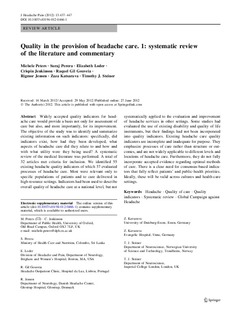| dc.contributor.author | Peters, M. | |
| dc.contributor.author | Perera, S. | |
| dc.contributor.author | Loder, E. | |
| dc.contributor.author | Jenkinson, C. | |
| dc.contributor.author | Gil Gouveia, R | |
| dc.contributor.author | Jensen, R. | |
| dc.contributor.author | Katsarava, Z. | |
| dc.contributor.author | Steiner, Timothy J. | |
| dc.date.accessioned | 2019-10-17T12:09:31Z | |
| dc.date.available | 2019-10-17T12:09:31Z | |
| dc.date.created | 2012-10-12T11:23:09Z | |
| dc.date.issued | 2012 | |
| dc.identifier.citation | The Journal of Headache and Pain. 2012, 13 (6), 437-447. | nb_NO |
| dc.identifier.issn | 1129-2369 | |
| dc.identifier.uri | http://hdl.handle.net/11250/2622784 | |
| dc.description.abstract | Widely accepted quality indicators for headache care would provide a basis not only for assessment of care but also, and more importantly, for its improvement. The objective of the study was to identify and summarize existing information on such indicators: specifically, did indicators exist, how had they been developed, what aspects of headache care did they relate to and how and with what utility were they being used? A systematic review of the medical literature was performed. A total of 32 articles met criteria for inclusion. We identified 55 existing headache quality indicators of which 37 evaluated processes of headache care. Most were relevant only to specific populations of patients and to care delivered in high-resource settings. Indicators had been used to describe overall quality of headache care at a national level, but not systematically applied to the evaluation and improvement of headache services in other settings. Some studies had evaluated the use of existing disability and quality of life instruments, but their findings had not been incorporated into quality indicators. Existing headache care quality indicators are incomplete and inadequate for purpose. They emphasize processes of care rather than structure or outcomes, and are not widely applicable to different levels and locations of headache care. Furthermore, they do not fully incorporate accepted evidence regarding optimal methods of care. There is a clear need for consensus-based indicators that fully reflect patients’ and public-health priorities. Ideally, these will be valid across cultures and health-care settings. | nb_NO |
| dc.language.iso | eng | nb_NO |
| dc.publisher | BMC (part of Springer Nature) | nb_NO |
| dc.rights | Navngivelse 4.0 Internasjonal | * |
| dc.rights.uri | http://creativecommons.org/licenses/by/4.0/deed.no | * |
| dc.title | Quality in the provision of headache care. 1: systematic review of the literature and commentary | nb_NO |
| dc.type | Journal article | nb_NO |
| dc.type | Peer reviewed | nb_NO |
| dc.description.version | publishedVersion | nb_NO |
| dc.source.pagenumber | 437-447 | nb_NO |
| dc.source.volume | 13 | nb_NO |
| dc.source.journal | The Journal of Headache and Pain | nb_NO |
| dc.source.issue | 6 | nb_NO |
| dc.identifier.doi | 10.1007/s10194-012-0466-1 | |
| dc.identifier.cristin | 950294 | |
| dc.description.localcode | Open Access This article is distributed under the terms of the Creative Commons Attribution 2.0 International License (https://creativecommons.org/licenses/by/2.0), which permits unrestricted use, distribution, and reproduction in any medium, provided the original work is properly cited. | nb_NO |
| cristin.unitcode | 194,65,30,0 | |
| cristin.unitname | Institutt for nevromedisin og bevegelsesvitenskap | |
| cristin.ispublished | true | |
| cristin.fulltext | original | |
| cristin.qualitycode | 1 | |

